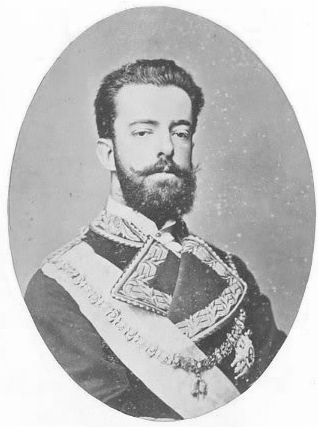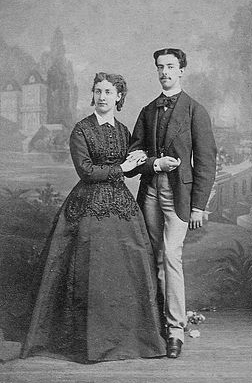<Back to Index>
- Psychologist Pierre Marie Félix Janet, 1859
- Sculptor Alexander Porfyrovych Archipenko, 1887
- King of Spain Amadeo I, 1845
PAGE SPONSOR


Amadeo I (Italian Amedeo, sometimes anglicized as Amadeus) (30 May 1845 – 18 January 1890) was the only King of Spain from the House of Savoy. He was the second son of King Victor Emmanuel II of Italy and was known for most of his life as Duke of Aosta, but reigned briefly as King of Spain from 1870 to 1873.
Granted the hereditary title Duke of Aosta in the year of his birth, he founded the Aosta branch of Italy's royal House of Savoy, which is junior in agnatic descent to the branch descended from King Umberto I that reigned until 1946, but senior to the branch of the Dukes of Genoa. Prince Amedeo of Savoy was born in Turin, Italy. He was the second son of Victor Emmanuel II (King of Piedmont, Savoy, Sardinia and, later, first King of Italy) and of Archduchess Adelaide of Austria. He was styled the Duke of Aosta from birth. In
1867 his father yielded to the entreaties of parliamentary deputy
Francisco Cassins, and on 30 May of that year, Amedeo was married to Donna Maria Vittoria del Pozzo.
The king initially opposed the match on the grounds that her family was
of insufficient rank, as well as his hopes for his son's marriage to a
German princess. Despite her princely title, donna Maria Vittoria was not of royal birth, belonging rather to the Piedmontese nobility. She was, however, the sole heiress of her father's vast fortune, which subsequent Dukes of Aosta inherited, thereby obtaining wealth independent of their dynastic appanage and allowances from Italy's kings. Maria Vittoria's mother, Louise de Mérode, granddaughter of the Prince de Rubempré and of the Princess van Grimberghe, belonged to one of Belgium's premier noble houses, and had married the Principe della Cisterna in 1846 in a double wedding with her younger sister Antoinette, who married Charles III, the reigning Prince of Monaco. Yet
by March of 1870, the Duchess found herself appealing to the King to
remonstrate with his son for marital infidelities that caused her hurt
and embarrassment. But the King wrote in reply that, while
understanding her feelings, he considered that she had no right to
dictate her husband's behavior and that her jealousy was unbecoming. After the Spanish revolution deposed Isabella II, the new Cortes decided to reinstate the monarchy under a new dynasty. The Duke of Aosta was elected King as Amadeus (Amadeo) on 16 November 1870. He swore to uphold the constitution in Madrid on 2 January 1871. The election of the new King coincided with the assassination of General Juan Prim,
his main backer. After that, Amadeo had to deal with difficult
situations, with unstable Spanish politics, republican conspiracies, Carlist uprisings, separatism in Cuba, intraparty disputes, fugitive governments and assassination attempts. He
could only count on the support of the progressive party, whose leaders
were trading off in the government thanks to parliamentary majority and
electoral fraud. The progressives divided into monarchists and
constitutionalists, which made the instability worse, and in 1872 a
violent outburst of interparty conflicts hit a peak. There was a
Carlist uprising in the Basque and Catalan regions,
and after that, republican uprisings happened in cities across the
country. The artillery corps of the army went on strike, and the
government instructed the King to discipline them. With
the possibility of reigning without popular support, Amadeus issued an
order against the artillery corps and then immediately abdicated from the Spanish throne on 11 February 1873. At ten o'clock that same night, Spain was proclaimed a republic, at which time Amadeo made an appearance before the Cortes, proclaiming the Spanish people ungovernable. Completely disgusted, the ex-monarch left Spain and returned to Italy, where he resumed the title of Duke of Aosta. After the death of his first wife, he married his French niece, Princess Maria Letizia Bonaparte (20 November 1866 – 25 October 1926), daughter of his sister Maria Clotilde and of Napoléon Joseph Charles Paul Bonaparte, a nephew of Napoleon I. They had one child, Umberto (1889 - 1918), who died of the flu during WWI. Amadeo remained in Turin, Italy until his death on 18 January 1890, less than two years after marrying his second wife. Puccini composed Crisantemi, an elegy for string quartet, in his memory. Lake Amadeus in central Australia is named for him. The first Spanish Republic lasted less than one year, and in 1875 Alfonso XII, the son of Isabella II, was proclaimed king, with Antonio Cánovas del Castillo, Spanish intermittent prime minister from 1873 until his assassination in 1893, briefly serving as regent. A municipality in the province of Cavite, Philippines is named after him (Municipality of Amadeo). The wedding day of Prince Amedeo and Donna Maria Vittoria was marred by the following tragic events: The best man shot himself. The Palace Gatekeeper slit his throat. The King's aide died after falling from his horse. The bride's wardrobe mistress hanged herself. The colonel leading the wedding procession collapsed from sunstroke. The stationmaster was crushed to death under the wheels of the honeymoon train. It
was said of him that he was neither very intelligent nor very
cultivated, and not well-liked by his Spanish subjects. For instance,
legend has it that once, whilst he was going for a drive around Madrid in his carriage, his secretary pointed out that the house they where passing by was that of the famous writer Miguel de Cervantes, upon which he replied that "Well, if he is so famous, even though he has not come to see me yet, I'll pay him a visit soon". Cervantes had died 200 years earlier.